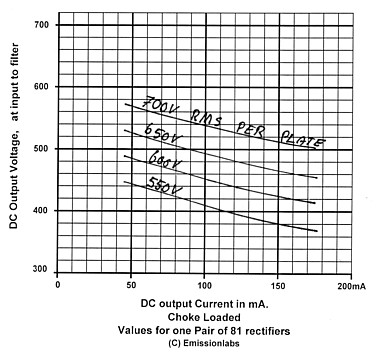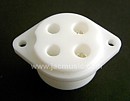81 Mono Diode Data Sheet
Description
The 81 was historically intended for use with the Type 50 tube. The 81 is a classical mono diode for relatively high voltage, such as found with large directly heated triodes. Normally two 81 tubes are used for full wave rectification. The heaters of two tubes should be put in parallel, thus the equivalent of a normal dual diode will result. In this configuration It can produce conveniently an output voltage of 500....700 Volt, at maximum 170mA. Other than dual diodes such at 5U4G, a pair of 81 can be used at maximum voltage and maximum current at the same time.
Note, it takes two 81 monodiodes to build a rectifier circuit, which is actually more powerful than a 5U4G circuit.
|
The EML tubes feature a series connected filament for both diodes togetherm, which has certain advantages. This tube can supply 140mA with a normal C-L-C filter. The 274A and 274B are designed for Audio purposes, and best use is with a small size first capacitor. The EML 274 is also specially suited for applications with relatively high DC voltage. The new ceramic sockets we use sind 2011, are make this possible. |
Guarantee program for first owner
The first owner can register the tube within 4 weeks after receival, at the Emission Labs ® website, to participate in the 5 years guarantee program, which is additional to the legal obligations of the seller.
Register here for the 5years guarantee
Features
 Soft rubber suspended tube base
Soft rubber suspended tube base- Hard metal Construction (Note1)
- Extra large getters
- Hand blown Glass bulb
- These tubes are shipped in a high quality dual box
- Tube printing with real gold (metal), red color is glass burned into the glass
- YAMAMOTO tube sockets highly recommended.
- Gold Plated pins,black ceramic socket.(White bottom.)
Sound Character of the 81
We try to answer this question if posssible. The 50 triode will give it's best performance at a relative high voltage. The 81 diode has a larger anode distance as useual. This makes the impedance higher, and the characteristic of this tube softer. The 81 diode is the most genuine tube to use together with the 50 triode, since it was originally designed fot this use. Also constrictionwise the 81 looks a lot like the 50 itself. When using this tube, the whole amplifier comes with 7.5 Volts heaters, which have a nicer glow appearance then the 5V heaters.
To a construct useual dual rectifier, the heaters of two diodes are connected in parallel.
For very small amplifiers, such as head phones, it is possible to use just one monodiode.
For ultra low ripple, it is recommended to use the Lundahl LL1673 dual coil choke in low CMR configuration. In this configuration, there is virtually no field radiation from the choke. (See link to circuit diagram, at the bottom of this page).
Filament Ratings for one diode |
|
| Filament Voltage | |
| Filament Current | |
Maximum ratings for a PAIR of diodes
|
|
AC input voltage |
700Volts |
DC output current, for a PAIR of tubes |
170mA |
| Copper Resistance of transformer minimum value. Add normal resistor if copper resistance is too low. (so if you have 120 Ohms, you need to add 80 ohms or more) | 200 Ohms |
| First capacitor, connected to Anodes | |
Full Wave Rectification with a pair of 81 tubes.Capacitor loaded (4uF) Some examples from |
 |
||
Transformer Voltage |
DC Output Voltage |
DC Output Current |
|
500-0-500V |
580V= |
40mA= |
|
500-0-500V |
520V= |
90mA= |
|
500-0-500V |
443V= |
170mA= |
|
450-0-450V |
510V= |
40mA= |
|
450-0-450V |
460V= |
90mA= |
|
450-0-450V |
382V= |
170mA= |
|
Full Wave Rectification with a pair of 81 tubes. Choke loaded, for instance Some examples from |
 Note, with a choke input, the load regulation is much better, it is approximately twice as good as capacitor loaded. Note, with a choke input, the load regulation is much better, it is approximately twice as good as capacitor loaded. |
|
Transformer Voltage |
DC Output Voltage |
DC Output Current |
600-0-600V |
490V= |
40mA= |
600-0-600V |
460V= |
90mA= |
600-0-600V |
440V= |
170mA= |
550-0-550V |
450V= |
40mA= |
550-0-550V |
418V= |
90mA= |
550-0-550V |
371V= |
170mA= |
81 Mechanical Data |
|
|
Tube Size including Socket:
|
Tube weight |
|
Shipped weight for double box with one pair |
|
Some Design Notes for Tube Power Supply
Notes
- Good care should be taken when making the design of any DHT rectifier. It must be prevented to have strong current peaks, through the first capacitor, because consequently this flows through the tube anode, and transformer windings as well. The transformer will produce mechanical hum by this, most specially if windings symmetry fails. Also the tube will suffer. For this reason, the first capacitor (C1) should never be larger than stated in this data sheet. The mechanical transformer hum, and also tube current peaks are greatly reduced by smaller capacitor values, and use higher choke values instead. Although higher capacitor values come at lower cost, using lower capacitors and higher chokes values instead, is always more satisfactory in the end. The result will be: Lower transformer hum, less electrical field radiation into the pre-amp, and more lifetime from the rectifier tube. This is why we recommend using largest chokes. From Lundahl, high value chokes are achievable at the same price as HiFi capacitors, like from a Mundorf or Black gate. So we have to go back to the roots, and use high quality, large value chokes, like in the old days of radio design. For best ripple suppression, increase the choke to any value you need, or even use an C-L-C-L-C circuit, as also advised in the historical RCA data sheet.
- As a rule of thumb, high voltage power supplies are work best with large size chokes, specially at high output current, whereas low voltage power supplies are more conveniently build with larger capacitors


